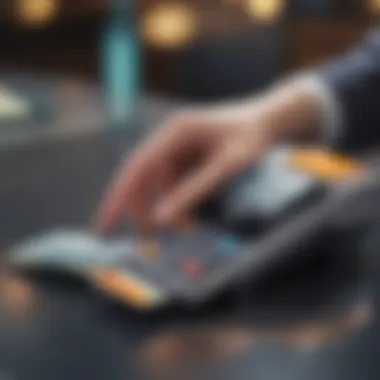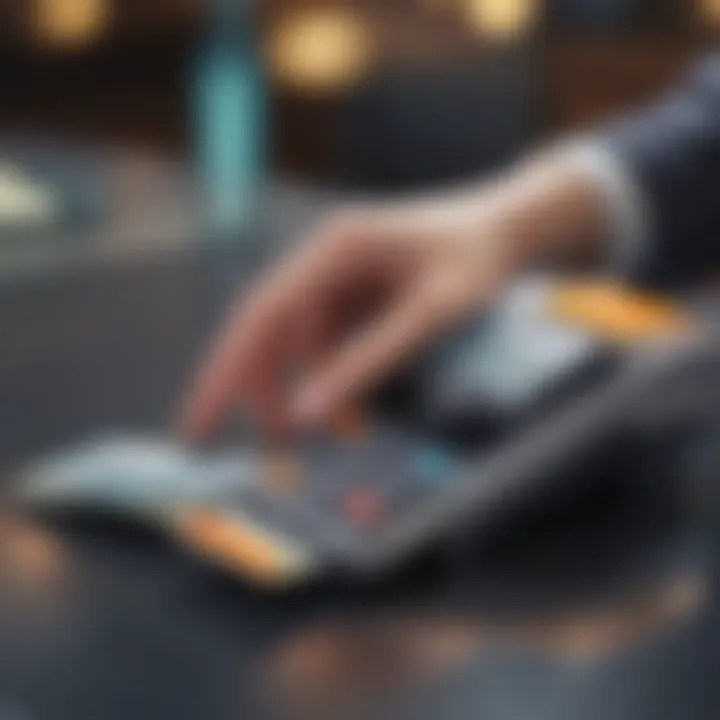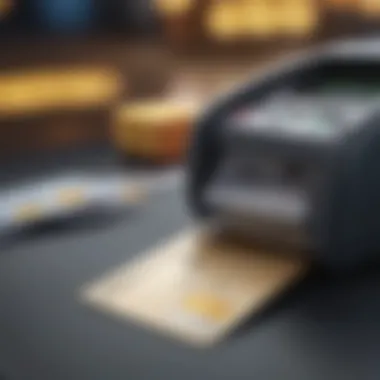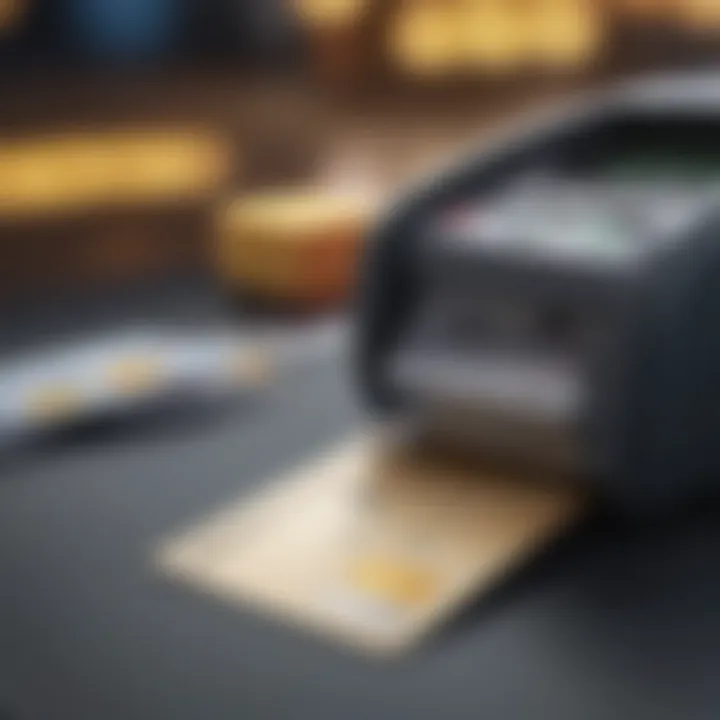Effective Strategies for Paying Credit Card Bills


Intro
Making timely payments on credit card bills is no walk in the park for many. It’s akin to walking a tightrope; one misstep can plunge one's credit score deep into the abyss. As the saying goes, better safe than sorry. Understanding your options and the terminology involved can greatly alleviate financial anxiety.
Let’s face it, navigating the landscape of credit card bills can be a bit of a maze, with a plethora of choices available. From writing checks that may or may not reach the issuer on time to the sleek convenience of mobile payments – each method carries its own set of upsides and pitfalls. The aim here is not just to pay your bills but to carve out a smart strategy that keeps your credit score robust and your wallets feeling a little fuller.
As we tread through this article, we will break down the ins and outs of different payment methods, explore their respective pros and cons, and equip you with the knowledge to choose what aligns with your lifestyle. Knowing the lay of the land will bring clarity, and in the world of finance, clarity can be the difference between stress and serenity. So let’s dive right into it!
Understanding Credit Card Payments
Grasping the ins and outs of credit card payments is fundamental for anyone using credit. It’s a little like holding the keys to a car; if you don’t know how to operate it properly, you might end up in a ditch. In today’s fast-paced financial environment, understanding these payments can be a game changer. Timely payments not only enhance credit scores but also foster a sense of financial control and stability that many aspire to achieve.
The Importance of Timely Payments
Timeliness in payments is often the lifeblood of maintaining a good credit reputation. Late payments can shatter credit scores like glass, leading to higher interest rates and a mountain of debt that can be hard to climb. Making on-time payments is not just a best practice; it’s vital. It speaks volumes about one’s financial responsibility and can save money down the line. Many credit card companies offer incentives for timely payments, such as cash back or rewards points, which can help to balance out costs. Moreover, establishing a habit of paying cards on or before the due date helps in building a solid credit history over time.
Consequences of Late Payments
Falling behind on credit card payments can feel like a snowball rolling downhill — it gathers speed and size unless you take action. The immediate consequences usually involve late fees that stack up fast. These can add a substantial amount to your bill if you’re not careful. Furthermore, after a missed payment, credit scoring models typically consider this as a major red flag.
Here’s what can happen if you miss payments:
- Increased Interest Rates: Many credit cards have an APR that can jump dramatically after just one missed payment. This can mean that the original bill can suddenly swell without you even realizing it.
- Diminished Credit Score: Just one late payment can knock several points off your credit score. If you imagine your credit score as the report card of your finances, a late payment is like getting an F.
- Account Restrictions: Some credit card issuers may impose limits on your spending or even close your account if timely payments are not maintained.
- Collection Actions: If late payments accumulate and go unresolved, accounts may be sent to collection agencies, creating financial havoc.
In summary, timely payments can lead to financial rewards, while late payments can ignite a cascade of negative effects. Being proactive and diligent about understanding and managing credit card payments can pave the path to financial health, enabling individuals to navigate their fiscal journeys with confidence.
Traditional Payment Methods
Traditional payment methods for credit cards have stood the test of time, demonstrating their continued relevance even in a digital world. These methods provide an essential anchor, especially for those who prefer tangible means of managing their finances. It’s important to acknowledge not only what makes these methods valuable but also the considerations that come with each.
Payment by Check
Writing a check may seem like a relic of the past, but it remains a viable option for credit card payments. This approach offers not only a physical record of the transaction but also an opportunity for some people to manage their spending more carefully.
Advantages of Using Checks
Using checks for bill payments has several noteworthy advantages. One primary benefit is the control it offers. When you write a check, you decide the exact amount that will leave your account, which can align well with your budgeting strategy. This aspect appeals particularly to those who dislike automatic withdrawals for fear of overspending. Furthermore, checks provide a paper trail, which is invaluable for tracking expenses and managing your finances over time.
- Unique Features: The tangible nature of checks can help individuals visualize their spending. Holding a check before mailing it can encourage one to think twice about the purchase it represents.
- Secure Option: For many, checks are seen as secure, since they don’t carry the same risk of fraud common with electronic transfers. You can place a stop payment if needed, which adds a layer of financial safeguarding.
However, checks also have their drawbacks, which shouldn't be ignored.
Potential Drawbacks
On the flip side, using checks can come with challenges. One significant consideration is the timeliness of payments. Mailing a check takes time, and if you send it too close to your due date, it might not be received in time to avoid late fees. This can lead to stress and potential damage to your credit score.
- Bank Processing Delays: Even after mailing, checks aren't instant. The bank may take a few days to process, which puts the payer at risk if they don't have a clear picture of their remaining balance.
- Overdraft Potential: If someone is not careful, they might not have sufficient funds when the check is cashed, leading to overdraft fees or bounced checks.
Bank Transfers
Another popular traditional method is bank transfers, which allows payments to be made directly from one bank account to another. This method’s appeal lies in its directness and simplicity.
Setting Up Transfers
Setting up bank transfers can feel straightforward, but it requires attention to detail. Whether it’s setting up one-time payments or recurring transfers, linking your credit card issuer directly to your bank account enhances convenience. Many people appreciate the seamless nature of this option since they don't have to remember to write a check or physically go to the bank.
- Automation: Once set up, the transfer can proceed without further action, reducing the mental load of remembering each due date. This option is particularly beneficial for those who manage multiple bills each month.
- Instant Payment Options: Some transfers may be processed on the same day, which can be advantageous for individuals hustling to meet deadlines.
Nonetheless, setting up bank transfers can also present its share of hurdles.


Timing Considerations
Timing is critical when it comes to bank transfers. Although some transfers can be instant, others may take longer, which can cause payments to arrive late. If you're not familiar with your bank’s processing times, this can become a precarious game of catch-up.
- Business Hours: Payments initiated over weekends or holidays typically won't be processed until the next business day. For busy professionals, this can lead to possible oversights.
Even a slight delay can result in late fees, which further complicates financial planning.
- Withdrawal Limits: Some banks impose limits on transfer amounts, which can be a headache if you’re trying to pay down a substantial balance swiftly. Understanding these limitations in advance can save potential frustration.
To sum it up, while bank transfers offer a direct and often efficient means of paying credit card bills, both the setup process and the timing of transfers should be managed carefully to ensure they align with payment deadlines.
Online Payment Options
Online payment options provide a modern and efficient way to handle credit card bill payments. As technology continues to evolve, these methods have become increasingly popular, offering convenience and speed that traditional payment methods often lack. For individuals looking to stay on top of their financial obligations, online payments can be a game-changer. They allow for flexibility and immediate access to account information, helping users manage their finances more effectively.
Credit Card Issuer Websites
Step-by-Step Payment Process
Paying your credit card bill through the issuer's website is a straightforward process designed for ease of use. First, you log into your account using secure credentials. Next, the interface typically guides you through selecting the payment amount, ensuring clarity on your outstanding balance. Once chosen, users are prompted to confirm the payment method – whether it’s from a checking account, savings account, or other sources.
What's particularly appealing about this step-by-step process is its simplicity. It is generally user-friendly, enabling even those who may not be tech-savvy to complete transactions without a hitch. One downsides could be the potential for temporary website outages, however, the overall user experience tends to be smooth. The biggest draw for many is the immediate effect on your account status; payments are usually processed in real-time, which positively affects credit utilization.
Security Measures
Security is paramount when it comes to online transactions. Credit card issuer websites have robust security measures in place to protect user data and financial information. This usually includes encryption technology, which secures data during transmission, and multi-factor authentication, adding another layer of protection during the login process.
The high level of security found on these websites is what makes them a preferred choice for many consumers. Users can feel safe conducting financial transactions knowing that their information is well-protected. However, it’s vital to be vigilant about personal devices, as security can be compromised if accessed through public Wi-Fi networks. This means users must regularly update software and maintain strong passwords to safeguard their accounts.
Mobile Banking Applications
User-Friendly Features
Mobile banking apps come equipped with various user-friendly features that enhance the payment process for consumers. Users can navigate through their financial landscape with options for setting reminders for due dates, viewing transaction history, and managing budgets right from their smartphones. The intuitive design of these apps often makes finding necessary functions quite effortless, which adds to user satisfaction.
Moreover, many apps allow for the setup of face recognition or fingerprint authentication, making the login process not only secure but also ultra-convenient. One potential drawback is that app updates may sometimes move things around, causing momentary confusion for recurring users. Nonetheless, the easier access to virtually all financial interactions remains a solid reason to embrace mobile banking.
Potential Risks
However, the convenience of mobile banking is not without its risks. One of the main concerns is the susceptibility to cyber-attacks or unauthorized access if users aren’t careful. If a device is lost or stolen, sensitive information may end up in the wrong hands. Additionally, using mobile banking apps over unsecured networks can significantly raise the risk of compromise.
A proactive approach in maintaining device security, such as utilizing legitimate antivirus software and being cautious about app permissions, is vital for a positive experience. Being aware and cautious helps mitigate the potential pitfalls associated with these digital conveniences, ultimately allowing for responsible management of credit card bills.
Automated Payment Systems
Automated payment systems have increasingly become a cornerstone for managing credit card bills efficiently. These systems benefit both consumers and financial institutions alike by reducing the chances of late payments, which can negatively impact credit scores. At their core, automated payments simplify the bill-paying process, allowing individuals to focus their time and attention elsewhere, rather than on remembering due dates or writing checks. In today's fast-paced financial environment, such convenience is invaluable.
However, while automated payment options offer structure and reliability, they require careful monitoring and understanding to maximize use while mitigating potential pitfalls.
Setting Up Recurring Payments
Benefits of Recurring Payments
Recurring payments shine brightly in the world of bill management, particularly for those who may struggle with sticking to a schedule. By automating payments to occur at regular intervals—monthly, bi-weekly, or even weekly—individuals can rest easy knowing that their bills are handled without a second thought. One key characteristic of recurring payments is their ability to ensure that payments are made consistently, which contributes to maintaining a positive credit history.
This systematic approach not only alleviates the hassle but also aids in creating a disciplined financial habit. Considering its capacity to reduce anxiety and save time, recurring payments stand out as a beneficial approach for those looking to streamline their finances.
In addition to the overarching benefits, one unique feature of recurring payments is its flexibility in amount adjustments. If a balance fluctuates—because of purchases, promotions, or changes in billing cycles—one can often modify the payment amount in the system accordingly. However, a downside includes the risk of overdraft if not managed properly, necessitating an active approach to monitor one's bank balance.


Managing Automated Payments
Managing automated payments effectively is essential to maximizing their benefits while avoiding potential pitfalls. Central to this management is keeping track of all charges against the linked financial account. Users must recognize that their obligations don't simply vanish; they need to remain vigilant about their financial landscape even when paying bills automatically.
One of the primary advantages of automated payment systems is the ability they provide users to set specific parameters. For example, knowing payment dates, reviewing account statements regularly, and confirming that adequate funds are available in one’s checking account can eliminate the surprises that may arise.
The unique feature of managing these payments is the ability to directly receive updates regarding transactions, allowing users to be proactive rather than reactive in their financial approach. However, managing too many automated payments can lead to confusion regarding effective budgeting, particularly if one doesn’t keep a close eye on their accounts.
Notifications and Alerts
Staying Informed
Staying informed is a critical piece of maintaining healthy financial habits with automated payment systems. The ability to receive notifications—whether by email, text, or within an app—serves as a reminder of upcoming payments or changes in billing schedules. A vital characteristic of staying informed is that it adds a layer of transparency to automatic transactions.
This transparency can help avoid unexpected charges, preventing disastrous overdrafts. Moreover, notifications help better manage one's total financial picture. Despite this clarity, there's a need to balance notification frequency; too many alerts can lead to desensitization, making it easy to overlook important messages.
Customization Options
Customization options allow users to tailor their alert settings based on personal preferences, providing another layer of flexibility in managing automated payments. Rather than receiving a flood of notifications for every transaction, individuals can opt for reminders only when payments exceed a set threshold or when certain bills are due.
This degree of personalization means that users can prioritize their attention, focusing on bills that matter most to them while filtering out less critical alerts. A unique advantage of customization is the potential to set alerts during specific timeframes, such as a day before each payment is due, which can serve as a helpful nudge without becoming overwhelming. While it enhances user experience, customizing preferences requires intentionality—a one-time setup that requires infrequent revisiting to ensure accuracy and efficiency.
Mobile Payment Technologies
In recent years, mobile payment technologies have revolutionized how we manage credit card bill payments. These innovative platforms allow users to conduct transactions from their smartphones, adding convenience and flexibility to their financial routines. With the swift rise of digital wallets and peer-to-peer payment services, understanding these technologies becomes essential to navigating modern personal finance effectively.
Payment Wallets
Overview of Payment Wallets
Payment wallets, sometimes known as digital wallets, function as an electronic wallet that securely stores users' payment information. These wallets allow individuals to link their credit cards, bank accounts, and other payment methods to a single platform. The primary appeal of payment wallets lies in their capacity to streamline transactions. Users can make purchases, pay bills, or send money without needing to whip out their physical cards. This not only saves time but also reduces the risk of losing cards.
In today’s fast-paced world, where time is money, opting for a payment wallet might seem like a no-brainer. Their significant characteristic is convenience, enabling users to initiate payments quickly and effortlessly. A unique feature of many payment wallets is their use of near-field communication (NFC) technology, which allows users to complete transactions simply by tapping their phone on a compatible payment terminal.
However, while payment wallets boast numerous advantages, there are some drawbacks. Potential security issues related to data breaches can make users hesitant. But with strong encryption methods and advanced security protocols becoming increasingly common, many find the benefits outweigh the risks.
Integration with Credit Cards
The integration of payment wallets with credit cards is a crucial element that enhances their utility. Users can directly synchronize their credit cards with these apps, allowing for seamless transactions without manually entering card details each time. This is another way the modern consumer enjoys ease. The key benefit of this integration is speed; it significantly reduces the time it takes to process a payment, which can be pivotal in places with long lines.
Moreover, many payment wallets offer features like tracking spending habits and providing insights into user expenditures. This can be especially advantageous for those who are budget-conscious and want to keep a close eye on their finances.
However, an important consideration arises from this integration: users must remain vigilant about protecting their digital credentials. If someone were to gain unauthorized access to a payment wallet linked with credit cards, they might run into serious financial trouble.
Peer-to-Peer Payment Services
Peer-to-peer (P2P) payment services represent another pillar of mobile payment technologies. These platforms allow individuals to send money to one another directly, without involving a bank. This can be particularly useful for splitting bills, paying back friends, or conducting small transactions.
How They Work
P2P payment systems function as intermediaries, facilitating transactions between users. Users typically link their bank accounts or credit cards to the service and can send money by entering the recipient's information, like an email address or phone number. The simplicity of these transactions is a significant draw; they can often be completed in a matter of seconds.
A prime example of a P2P service is PayPal, which offers not just payment solutions but also options for managing business transactions. The unique feature is how these services can operate across different platforms, making them suitable for a wide audience. But on the downside, users should be cautious of potential fees that might be incurred for instant transfer options or transactions funded by credit cards.
Associating Accounts
For P2P payment systems to function effectively, users must associate their bank accounts or credit cards. This step is straightforward; users provide their banking information to the service, allowing the platform to draw from or deposit funds as needed. This is a significant aspect of using P2P payment services as it streamlines the funding process.
The benefit of this easy association is that users can manage their transactions quickly, which enhances the overall user experience. Users also enjoy the freedom of choice, as they can select which method of funding to use for different transactions. However, this fluidity also brings potential pitfalls. If users do not manage their linked accounts properly, they may risk overdrawing their account or facing unexpected fees.


"Mobile payment technologies not only simplify financial transactions but also reshape our understanding of how money moves in a digital age."
With such innovative solutions at our fingertips, consumers now have a plethora of options for managing credit card bill payments. As these technologies evolve, staying informed can help users make the most of their financial engagements.
Payment Strategies for Fiscal Management
Effective management of credit card payments is key for maintaining a sound financial strategy. If you want to keep your finances from going down the drain, employing solid payment strategies is like putting on a good set of tire for a road trip. You can't just wing it, especially if you are looking to bolster your credit score and promote savings. Strategies for fiscal management give you structure, allowing you to visualize the route ahead and steer clear of financial potholes.
Creating a Payment Schedule
Visualizing Payment Deadlines
Setting up a payment schedule is not just about jotting down dates on a calendar; it involves creating a visual roadmap that highlights when bills are due. Having these deadlines laid out in front of you helps avoid the stress of last-minute scrambles. Visual timelines can enhance your financial awareness. Think about it: when you clearly see upcoming deadlines, you're less likely to let payments slip through the cracks.
A common approach is using color-coded systems or digital calendars where alerts pop up as deadlines approach. This method is hugely beneficial for anyone juggling numerous financial obligations. The nice thing about this visualization is it can be quite personal, shaped by lifestyle and habits. However, there's a flip side; if you’re not disciplined, visual aids can become mere decoration rather than tools for action.
Adjusting for Budget Fluctuations
The financial landscape can be as unpredictable as the weather, which is why knowing how to adjust your payment schedule is essential. Life doesn’t always stick to a plan. Having a flexible approach to adjusting your payment commitments allows you to accommodate that surprise car repair or unexpected medical expense. This adaptability contributes to effective budgeting by ensuring that you don't fall off the wagon when expenses vary.
Many people opt to set aside a cushion in their budgets for those uncertain months. The key here is striking a balance—you don’t want to overextend yourself but at the same time, flexibility is what keeps you on track. Just remember, it’s a strategy that should come with some caution; constant adjusting without a clear strategy can lead to haphazard spending rather than financial agility.
Evaluating Payment Methods for Budgeting
An informed evaluation of various payment methods is critical. It's similar to weighing options for a major purchase; you wouldn't buy the first thing you see without checking the features and price, would you?
Cost-Benefit Analysis
Thinking about the cost-benefit aspects of each payment method really brings clarity. If you're tempted to pay by credit card for points but your budget is already stretched, this is where the rubber meets the road. A cost-benefit analysis will help you understand not only the immediate expenses but also the long-term implications of your choices.
This analysis frequently highlights advantages such as rewards points, cashback offers, and convenience against downsides like annual fees or interest rates. Ultimately, it’s about ensuring you’re making choices that align with your financial goals.
User Experiences
User experience is another pillar in evaluating payment methods. After all, what’s good in theory might not play out well in practice. Now, I ain’t saying you should take every online review at face value, but looking into how others navigated the payment process can shed light on pitfalls and perks you wouldn’t think to consider.
Incorporating user experiences into your planning spotlights real-world efficiency. Was the payment system easy to navigate? Did they encounter hidden fees? These first-hand accounts can steer your choices, guiding you toward options that truly enhance your fiscal management.
"It’s better to learn from the mistakes of others than to make them yourself."
Navigating the maze of credit card payments requires careful thought, a bit of flexibility, and a good eye for evaluating options. Taking these strategies to heart can set you on a smoother path toward better financial health.
Ending and Best Practices
In the world of credit card management, navigating the myriad of payment options is crucial. This article highlights how important it is to adopt the right approach to settle credit card bills. Not only does timely payment influence credit scores, but it also impacts financial health overall. Without good practices, one can easily fall into pitfalls like accumulating debt or affecting their creditworthiness.
Selecting the Right Method
When considering which payment method to use, think about efficiency, convenience, and personal compatibility. Each individual’s financial landscape is distinct, thus, it's essential to evaluate options based on your preferences. For instance:
- Recurring Payments: This suit folks who prefer automation. Setting up automatic payments helps avoid late fees. However, be mindful of the balances; it’s easy to overlook your spending if you aren’t checking often.
- Mobile Payment Apps: These modern tools often come with user-friendly features. However, app security can sometimes be a concern. Always ensure the app has robust encryption and user reviews support its safety.
- Traditonal Methods: Checks might seem outdated but can provide a sense of control. The downfall? They take longer to process and one may forget about them while managing digital channels.
With these preferences in mind, the best practice is to align your payment method with your financial habits. A stellar practice is to keep your options diverse, allowing flexibility in financial management.
Maintaining Awareness of Billing Cycles
Understanding billing cycles and payment due dates is like having a roadmap in financial management. When you are aware of when bills are due, how they align with your cash flow, and the total amount owed, you're gearing up for success. Some points to consider include:
- Track Your Billing Cycle: Most credit card companies send monthly statements. Familiarize yourself with the dates and set reminders a week before. This can prevent any last-minute rush which can lead to mistakes or late payments.
- Review Charges Regularly: During each billing cycle, take stock of your transactions. Did something look off? It's better to catch discrepancies early on than facing disputes later.
- Budget Accordingly: Knowing your billing cycles allows you to better allocate funds. Stay informed about when larger purchases might hit as well.
To sum it up, staying engaged with your billing cycle not only assists with timely payments but also empowers you to take control of your finances, allowing for a clearer view of your budgeting process.
"An ounce of prevention is worth a pound of cure." Staying proactive in managing credit card payments can save you from headaches down the road.
By selecting the right methods and maintaining awareness of billing cycles, you create a solid foundation for financial well-being. This guide is not just a one-time read; it should be a tangible part of your financial planning journey.



